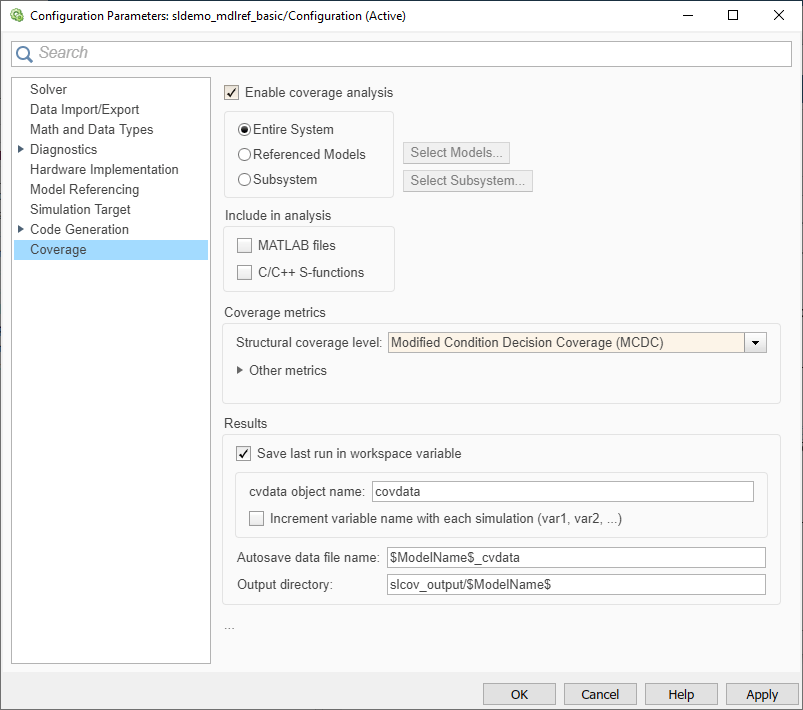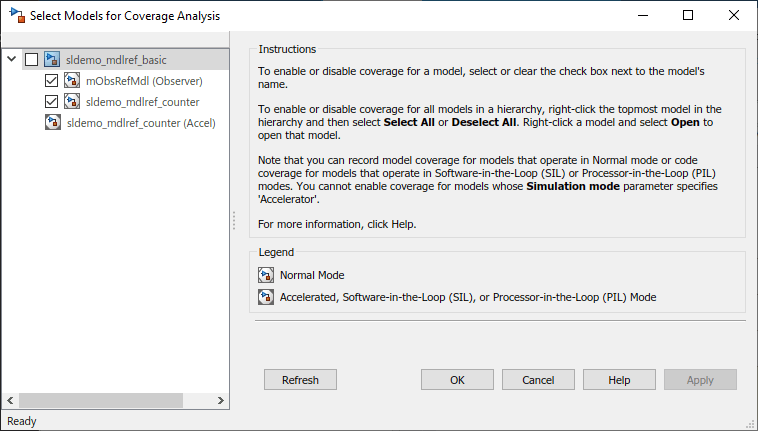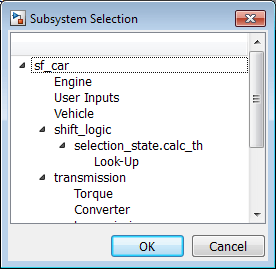指定覆盖率选项
在开始覆盖率分析之前,您需要指定多个覆盖率分析选项。在 App 选项卡上,点击覆盖率分析器。在覆盖率选项卡上,选择设置。
覆盖率窗格
在“配置参数”对话框的覆盖率窗格中,设置在仿真期间计算覆盖率时的相关选项。

启用覆盖率分析
在仿真期间收集指定的覆盖率结果并报告覆盖率。选择启用覆盖率分析后,以下部分将变为可供选择状态:
分析范围
指定软件收集并报告覆盖率数据的系统。选项包括:
您必须选择启用覆盖率分析才能指定分析范围。
整个系统
默认情况下,软件会为整个系统生成覆盖率数据。覆盖率结果涵盖顶层模型以及所有受支持的子系统和模型引用。
引用模型
收集您选择的引用模型和 Observer 模型的覆盖率。默认情况下,此设置会收集所有引用模型的覆盖率,其中 Model 模块的仿真模式为普通、软件在环(SIL) 或处理器在环(PIL),活动 Observer 模型的仿真模式为普通。
要指定 Simulink® Coverage™ 为其收集覆盖率数据的引用模型和 Observer 模型,请执行以下操作:
选择启用覆盖率分析。
对于分析范围,选择引用模型。
点击选择模型。

在“选择要进行覆盖率分析的模型”对话框中,选择要为其收集覆盖率的引用模型或 Observer 模型。您还可以选择顶层模型。
模型名称旁边的图标表示该引用模型的仿真模式。
如果您有多个 Model 模块引用同一模型且仿真模式相同,则选中该模型对应的复选框时,会选中该模型的所有具有相同仿真模式的实例的复选框。
点击确定。
子系统
覆盖率分析在仿真期间收集您选择的子系统的覆盖率。默认情况下,软件会为整个模型生成覆盖率数据。要限制为仅对特定子系统生成覆盖率报告,请执行以下操作:
在“配置参数”对话框的覆盖率窗格中,选择启用覆盖率分析。
点击选择子系统。

在“子系统选择”对话框中,选择要启用覆盖率报告的子系统,然后点击确定。
包括在分析中
包括在分析中部分包含以下两个选项:
MATLAB® 文件,为您的模型中 MATLAB 函数调用的任何外部函数启用覆盖率。您可以在 MATLAB Function 模块或 Stateflow® 图中定义 MATLAB 函数。
要选择 MATLAB 文件的覆盖率选项,您必须选择启用覆盖率分析。
C/C++ S-Function,为您的模型中的 C/C++ S-Function 模块启用覆盖率分析。软件会针对 S-Function 模块以及这些模块中的 C/C++ 代码报告覆盖率度量。有关详细信息,请参阅生成 S-Function 的覆盖率报告。
您必须选择启用覆盖率分析才能选择 S-Function 的覆盖率选项。
覆盖率度量
选择您希望工具执行的结构覆盖率等级和其他类型的测试用例覆盖率分析(请参阅模型覆盖率类型)。Simulink Coverage 会为您指定的子系统、模型和引用模型收集并报告以下类型的覆盖率。
结构覆盖率等级按测试用例覆盖率分析的严格程度依次列出:
模块执行 - 启用执行覆盖率 (EC)
决策 - 启用执行覆盖率 (EC)和决策覆盖率 (DC)
条件决策 - 启用执行覆盖率 (EC)、决策覆盖率 (DC)和条件覆盖率 (CC)
修正条件决策覆盖率 (MCDC) - 启用执行覆盖率 (EC)、决策覆盖率 (DC)、条件覆盖率 (CC)和修正条件/决策覆盖率 (MCDC)
覆盖率度量还包括其他度量:
您必须选择启用覆盖率分析才能选择覆盖率度量。
结果
在“覆盖率配置参数”的结果部分中,选择覆盖率结果的保存目标。您必须在覆盖率窗格中选择启用覆盖率分析才能设置结果选项。
将上次运行保存在工作区变量中 - 将上次仿真运行的结果保存在工作区的
cvdata对象中。在 cvdata 对象名称中指定工作区变量的名称。cvdata 对象名称 - 保存上次仿真运行结果的工作区变量的名称。您必须选择将上次运行保存在工作区变量中才能指定
cvdata对象名称。随每次仿真递增变量名称(var1、var2...) - 为每个新结果的工作区变量名称追加数字,以免覆盖之前的结果。您必须选择将上次运行保存在工作区变量中才能启用此选项。
自动保存数据文件名 - 保存覆盖率数据结果的文件的名称。默认名称为
$ModelName$_cvdata。$ModelName$是模型的名称。输出目录 - 保存覆盖率数据的文件夹。默认位置为当前文件夹中的
slcov_output/$ModelName$。$ModelName$是模型的名称。